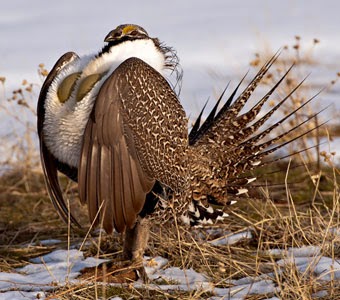Idaho's reflexive backwardness when it comes to wildlife conservation continues to astound US Person. A plan to poison intelligent ravens to save sage grouse was derailed by public outcry over the plan. The poisoning to be carried out by the infamous Department of Agriculture Wildlife Services has been postponed for a year while the federal agency completes a supplemental environmental assessment. {12.05.12, Uncle Sam's Exterminators} Ravens were supposed to be poisoned in three locations: the Idaho National Laboratory near Arco, the Curlew National Grasslands and in Washington County near the Oregon border. The wrong idea is that ravens ocasssionally prey on grouse eggs, so fewer ravens would result in more grouse hatching. Experts judge many threats to sage grouse to be more severe than ravens. Besides, ravens are thriving because of man-made changes to grouse habitat. A number of conservation organizations including the National Audubon Society made written protests to US Secretary of Agriculture about the plan to poison ravens. The Idaho legislature apparently has been pressuring Idaho Fish and Game officials to reduce raven populations. It appropriated $100,000 for the misguided effort. Grouse is a highly regarded game bird eventhough it is struggling to survive on radically altered sagebrush prairie.
A state senator who promoted raven killing and brought federal Wildlife Services into a state legislative committee to advance the bill has earned a reputation for introducing controversial, US Person would say brutal, legislation. He once introduced a bill to use dogs as wolf bait, but fortunately that was too cruel even for Idahoans. According to the biodiversity director of Western Watersheds Project, whose comments were published in an Idaho newspaper, ravens are being scapegoated so government subsidized grazers can prevent changes in the management of grazing on what they consider their exclusive domain by right. Several Idaho legislators are public land ranchers that pay only $1.35/mo per cow to graze public grass. The Agricultural Research Service, another arm of the USDA found that cattle sharing sage grouse range will consume grass tussocks between sagebrush and continue consuming tussocks growing underneath sagebrush where grouse build their nests. In order to preserve sage-grouse populations, ranchers must move their herds before that happens. Hard boiled eggs stuffed with non-specific DRC-1339 may yet be strewn across Idaho's public lands if these very special interest legislators continue to have their way.

